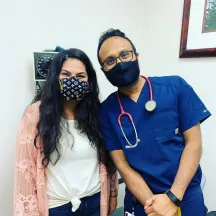
Living well with an ostomy
Less than 10% of colorectal cancer patients require a permanent ostomy, while many get a temporary ileostomy.
Having the right information and resources can allow anyone with an ostomy thrive!


What is an ostomy?
An ostomy is a surgery that creates a stoma opening that lets waste exit the body.
Many patients refer to their stoma as an ostomy.
An estimated 18-35% of colorectal cancer survivors have received temporary or permanent ostomies as part of their treatment.

Adjusting to life with an ostomy bag
You are not alone.
Nearly one million Americans are living with an ostomy. By following a few steps, you can live life just as you did before.

Nutrition with an ostomy
Good nutrition is essential for optimal health and well-being throughout your ostomy journey.

Hydration with an ostomy
Staying hydrated with an ostomy is as important as eating well. Keep your water bottle close by and choose hydrating foods.

Intimacy with an ostomy
People with an ostomy may find intimacy challenging at first, but with patience and modifications, your sex life can continue as it did before.

Ostomy support
Support is essential for all of us. Find a support group that fits your needs.

Ostomies and pain management
An ostomy should not be painful or uncomfortable. Learn how to recognize signs of trouble.

Physical activity with an ostomy
Exercise can speed up recovery, enhance balance and flexibility, boost self-confidence, increase energy, and more.
Gather your resources
Find a buddy, a navigator, an online community, and more with Alliance resources.
Top resources
Kat Sisler: From ostomy-opposed to ostomy-grateful
My cancer and ostomy journey began with a rude awakening in January 2023. My father was diagnosed with colorectal cancer at 42, and given that history, I asked my doctor at my yearly physical when I should begin screening.

Empowering lives: celebrating World Ostomy Day
Every year on the first Saturday of October, people worldwide come together to celebrate World Ostomy Day, also known as Ostomy Awareness Day. This day serves as a reminder of the resilience, strength, and courage millions of individuals display each year living with an ostomy.
How to cut and fit an ostomy wafer for a stoma
In this video, ostomate and certified patient and family support navigator Stephanie Rouse demonstrates how to cut and fit an ostomy wafer, or skin barrier, for a stoma.





